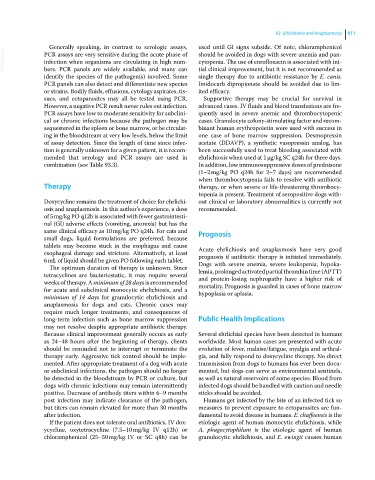Page 973 - Clinical Small Animal Internal Medicine
P. 973
93 Ehrlichiosis and Anaplasmosis 911
Generally speaking, in contrast to serologic assays, used until GI signs subside. Of note, chloramphenicol
VetBooks.ir PCR assays are very sensitive during the acute phase of should be avoided in dogs with severe anemia and pan-
cytopenia. The use of enrofloxacin is associated with ini-
infection when organisms are circulating in high num-
bers. PCR panels are widely available, and many can
single therapy due to antibiotic resistance by E. canis.
identify the species of the pathogen(s) involved. Some tial clinical improvement, but it is not recommended as
PCR panels can also detect and differentiate new species Imidocarb dipropionate should be avoided due to lim-
or strains. Bodily fluids, effusions, cytology aspirates, tis- ited efficacy.
sues, and ectoparasites may all be tested using PCR. Supportive therapy may be crucial for survival in
However, a negative PCR result never rules out infection. advanced cases. IV fluids and blood transfusions are fre-
PCR assays have low to moderate sensitivity for subclini- quently used in severe anemic and thrombocytopenic
cal or chronic infections because the pathogen may be cases. Granulocyte colony‐stimulating factor and recom-
sequestered in the spleen or bone marrow, or be circulat- binant human erythropoietin were used with success in
ing in the bloodstream at very low levels, below the limit one case of bone marrow suppression. Desmopressin
of assay detection. Since the length of time since infec- acetate (DDAVP), a synthetic vasopressin analog, has
tion is generally unknown for a given patient, it is recom- been successfully used to treat bleeding associated with
mended that serology and PCR assays are used in ehrlichiosis when used at 1 μg/kg SC q24h for three days.
combination (see Table 93.3). In addition, low immunosuppressive doses of prednisone
(1–2 mg/kg PO q24h for 2–7 days) are recommended
when thrombocytopenia fails to resolve with antibiotic
Therapy therapy, or when severe or life‐threatening thrombocy-
topenia is present. Treatment of seropositive dogs with-
Doxycycline remains the treatment of choice for ehrlichi- out clinical or laboratory abnormalities is currently not
osis and anaplasmosis. In this author’s experience, a dose recommended.
of 5 mg/kg PO q12h is associated with fewer gastrointesti-
nal (GI) adverse effects (vomiting, anorexia) but has the
same clinical efficacy as 10 mg/kg PO q24h. For cats and Prognosis
small dogs, liquid formulations are preferred, because
tablets may become stuck in the esophagus and cause Acute ehrlichiosis and anaplasmosis have very good
esophageal damage and stricture. Alternatively, at least prognosis if antibiotic therapy is initiated immediately.
6 mL of liquid should be given PO following each tablet. Dogs with severe anemia, severe leukopenia, hypoka-
The optimum duration of therapy is unknown. Since
tetracyclines are bacteriostatic, it may require several lemia, prolonged activated partial thrombin time (APTT)
and protein‐losing nephropathy have a higher risk of
weeks of therapy. A minimum of 28 days is recommended mortality. Prognosis is guarded in cases of bone marrow
for acute and subclinical monocytic ehrlichiosis, and a hypoplasia or aplasia.
minimum of 14 days for granulocytic ehrlichiosis and
anaplasmosis for dogs and cats. Chronic cases may
require much longer treatments, and consequences of
long‐term infection such as bone marrow suppression Public Health Implications
may not resolve despite appropriate antibiotic therapy.
Because clinical improvement generally occurs as early Several ehrlichial species have been detected in humans
as 24–48 hours after the beginning of therapy, clients worldwide. Most human cases are presented with acute
should be reminded not to interrupt or terminate the evolution of fever, malaise/fatigue, myalgia and arthral-
therapy early. Aggressive tick control should be imple- gia, and fully respond to doxycycline therapy. No direct
mented. After appropriate treatment of a dog with acute transmission from dogs to humans has ever been docu-
or subclinical infections, the pathogen should no longer mented, but dogs can serve as environmental sentinels,
be detected in the bloodstream by PCR or culture, but as well as natural reservoirs of some species. Blood from
dogs with chronic infections may remain intermittently infected dogs should be handled with caution and needle
positive. Decrease of antibody titers within 6–9 months sticks should be avoided.
post infection may indicate clearance of the pathogen, Humans get infected by the bite of an infected tick so
but titers can remain elevated for more than 30 months measures to prevent exposure to ectoparasites are fun-
after infection. damental to avoid disease in humans. E. chaffeensis is the
If the patient does not tolerate oral antibiotics, IV dox- etiologic agent of human monocytic ehrlichiosis, while
ycycline, oxytetracycline (7.5–10 mg/kg IV q12h) or A. phagocytophilum is the etiologic agent of human
chloramphenicol (25–50 mg/kg IV or SC q8h) can be granulocytic ehrlichiosis, and E. ewingii causes human

